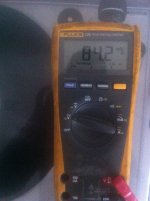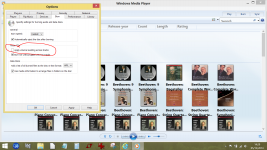Haven't read every page and I'll do the test soon. IMO, what would also be useful is to use the test to determine the maximum gain setting that insured no clipping. I assume calculate the maximum output of a given amp, then adjust for a specific output voltage on a low level test tone, then use blue painters masking tape to put an arrow on the volume control to mark the "0 dB from a CD" point. I like blue painters tape because it doesn't leave hard to remove goo, but I digress. Once the volume control is marked, you know if you always stay below that setting, CDs can never clip.
Conrad - yes. That is in essence what I've done. I know where on the volume dial my amps clip and so keep then below that point.
Finding that point is easy with a signal generator and an oscilloscope. Measuring distortion will also tell you were clipping starts. If you don't have those you'll have to work backwards for rail voltages or use the power rating, if you can trust it.
Finding that point is easy with a signal generator and an oscilloscope. Measuring distortion will also tell you were clipping starts. If you don't have those you'll have to work backwards for rail voltages or use the power rating, if you can trust it.
Except the many CDs that are recorded with built in digital clippingOnce the volume control is marked, you know if you always stay below that setting, CDs can never clip.
Conrad - yes. That is in essence what I've done. I know where on the volume dial my amps clip and so keep then below that point.
Finding that point is easy with a signal generator and an oscilloscope. Measuring distortion will also tell you were clipping starts. If you don't have those you'll have to work backwards for rail voltages or use the power rating, if you can trust it.
Sure, but the beauty of your low level tone approach is you can estimate the clipping point quite well without having to drive the amp that far, so long as the system response is flat. Use tone controls and all bets are off.
Yeah, but I don't buy those.Except the many CDs that are recorded with built in digital clipping.
Conrad: Of course if you use EQ or tone control boost, then those levels will be higher. You'd probably have to do a sweep to measure that.
I'm using a Fluke175 set to AC with MinMax enabled.
I measure 88mV.
speakers used are the 4" dual cone Chinese
http://www.diyaudio.com/forums/full-range/171707-chinese-taiwan-4-dual-cone-speakers.html
is this possible? I thought this is a rather low result....
I measure 88mV.
speakers used are the 4" dual cone Chinese
http://www.diyaudio.com/forums/full-range/171707-chinese-taiwan-4-dual-cone-speakers.html
is this possible? I thought this is a rather low result....
Bit of ambiguity in terminology there. Most meters are average reading but have a fiddle factor in the calibration to display an rms value (which is only accurate for a pure sine... as here)
True average of a sine is zero of course but in measurement (over one cycle) its actually 0.637 * vpk versus the 0.707 * vpk for rms.
True average of a sine is zero of course but in measurement (over one cycle) its actually 0.637 * vpk versus the 0.707 * vpk for rms.
It does sound low but then again it depends on how loud you ultimately play your system.
If you have set the volume to the highest you ever use while playing music discs then assuming your DVM is OK, the test is accurate. That's the beauty of a real measurement test... it takes the guesswork out of the analysis.
That single ended amp could be a reality
If you have set the volume to the highest you ever use while playing music discs then assuming your DVM is OK, the test is accurate. That's the beauty of a real measurement test... it takes the guesswork out of the analysis.
That single ended amp could be a reality
Bit of ambiguity in terminology there. Most meters are average reading but have a fiddle factor in the calibration to display an rms value (which is only accurate for a pure sine... as here)
True average of a sine is zero of course but in measurement (over one cycle) its actually 0.637 * vpk versus the 0.707 * vpk for rms.
I'm actually going to do this test one day, or test using fluke min max function to capture peak level at the loudest volume setting id use. (my fluke is way better than my hobby dmm, and apparently the better flukes are true rms, as opposed to MAD scaled to RMS. With a FR of 20hz to several tens of Khz, my work fluke kicks the proverbial)
FWIW I actually believe MAD is 0.637 of a Unipolar AC voltage, such as half rectified AC, or over a half cycle (not full cycle) of Sine. Although I say this tentatively as you know far more than me Mooly.
built a precision rectifier, and now i am delusional and believe I'm the boss
It does sound low but then again it depends on how loud you ultimately play your system.
Ah ok... so... I tested again
120Hz file
set the volume to play some music until the neighbors start hitting the wall

do the test again
that gives me 0.6V
please forgive for not reading all the other 99 pages, but can I calculate/convert this to wattage?
The peak is 4x your measurement or 2.4 volts and the rms 2.83x
So you need an amp of just under 0.4 watts rms... which sounds low but its not really given efficient speakers or more modest expectations of loudness. (I typically listen at way below that)
or,
0.6*0.6/ which is 0.36 watts. That is the rms amp power needed for an 8 ohm load (which we are basing this particular method on) based on your measurements.
The secret of Pano's test is in the -12db chosen for the test file and how that relates to the max full scale level from a digital source.
Remember that what you are actually measuring is voltage... and for the quick calculations an assumed 8 ohm load. All that matters is that your amp can maintain that maximum voltage across your chosen speakers.
(Hope I've done the maths correctly )
)
So you need an amp of just under 0.4 watts rms... which sounds low but its not really given efficient speakers or more modest expectations of loudness. (I typically listen at way below that)
or,
0.6*0.6/ which is 0.36 watts. That is the rms amp power needed for an 8 ohm load (which we are basing this particular method on) based on your measurements.
The secret of Pano's test is in the -12db chosen for the test file and how that relates to the max full scale level from a digital source.
Remember that what you are actually measuring is voltage... and for the quick calculations an assumed 8 ohm load. All that matters is that your amp can maintain that maximum voltage across your chosen speakers.
(Hope I've done the maths correctly
It doesn't quite work like that.
The "power" isn't something the amplifier puts out directly, its the resulting power that the load (speaker) dissipates or draws. So you need to ensure that the amp you are looking at can maintain the 0.6 volts you measured down into a 4 ohm load.
Your measured results are valid for your speaker and you find you need 1.7 volts rms output to meet your requirements. If you connect an 8 ohm speaker across 1.7vrms it "draws" 0.36 watts. A four ohm would draw twice that, 0.72 watts.
The "power" isn't something the amplifier puts out directly, its the resulting power that the load (speaker) dissipates or draws. So you need to ensure that the amp you are looking at can maintain the 0.6 volts you measured down into a 4 ohm load.
Your measured results are valid for your speaker and you find you need 1.7 volts rms output to meet your requirements. If you connect an 8 ohm speaker across 1.7vrms it "draws" 0.36 watts. A four ohm would draw twice that, 0.72 watts.
Another data point: I measured 1.8V on the 120Hz track and a small fraction
less on the second on.
I had problem with the first CD I burnt on my windows7 box. It seems
Windows Media Centre by defaults does some level adjustment when
burning tracks and it came out much louder than it should have been.
Dennis
less on the second on.
I had problem with the first CD I burnt on my windows7 box. It seems
Windows Media Centre by defaults does some level adjustment when
burning tracks and it came out much louder than it should have been.
Dennis
Osscar - thank you for posting your direct music measurement. Not everyone has such a nice voltmeter.  Your numbers make sense to me, that's a 14dB range. That would be typical on music that is mastered fairly loud, but not as loud as the crushed CDs now on the market.
Your numbers make sense to me, that's a 14dB range. That would be typical on music that is mastered fairly loud, but not as loud as the crushed CDs now on the market.
MoolY - thanks for the excellent posts. You were spot on. The test signal is 12dB RMS below the high possible peak. It is 9dB below the highest possible sine wave. It is important to understand that those are the same thing, just referenced differently.
It can be surprising how little voltage we actually get out of our amp outputs on a daily basis. If you get into a much larger space and higher SPL, the voltage will go up quickly. At home, it's usually pretty tame.
 Your numbers make sense to me, that's a 14dB range. That would be typical on music that is mastered fairly loud, but not as loud as the crushed CDs now on the market.
Your numbers make sense to me, that's a 14dB range. That would be typical on music that is mastered fairly loud, but not as loud as the crushed CDs now on the market.MoolY - thanks for the excellent posts. You were spot on. The test signal is 12dB RMS below the high possible peak. It is 9dB below the highest possible sine wave. It is important to understand that those are the same thing, just referenced differently.
It can be surprising how little voltage we actually get out of our amp outputs on a daily basis. If you get into a much larger space and higher SPL, the voltage will go up quickly. At home, it's usually pretty tame.
- Home
- Loudspeakers
- Multi-Way
- A Test. How much Voltage (power) do your speakers need?

